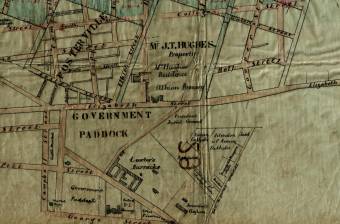Convict Ship Asia I (4)
1828
Embarked 100 men
Voyage 111
Deaths 0
Surgeon's Journal - Yes
Previous vessel: Morley arrived 3 March 1828
Next vessel: Mangles arrived 2 June 1828
Captain Thomas F. Stead.
Surgeon James McTernan
Convicts and passengers of the Asia identified in the Hunter Valley
The ship Asia made voyages to New South Wales with convicts in 1820, 1822, 1825, 1828, 1830, 1832 and 1833. [2]
The prisoners came from counties throughout England and Scotland. They were held on prison hulks prior to transportation. Many were transferred to the ship on 9th November 1827.
Departure from England
Asia departed London on 23 November 1827.Surgeon James McTernan
This was James McTernan's third voyage as surgeon superintendent on a convict ship. He was also employed as surgeon on the convict ships Ocean in 1823, Sir Charles Forbes in 1827 (VDL) Asia in 1828, Eliza in 1829, Lady Harewood in 1831, John Barry in 1836 and the Sara in 1837 (VDL).James McTernan kept a Medical Journal from 3 October 1827 to 24 March 1828. His journal begins .....
Although the general summary numerically viewed may give an idea of much sickness on board the Asia, few ships enjoyed a greater immunity which is principally to be attributed to the usual attention to cleanliness, dryness below, ventilation and indeed much to the fitness as to capacity of the Asia for such a service. Although the vessel was rendered uncomfortable for some time by the very bad fitting and consequent damp of a water closet.[1]
Cabin Passengers
Passengers included Solicitor-General John Sampson and Clerk.Military Guard
The guard comprised a detachment of the 57th Regt., with 7 men of the Royal Veterans and 5 women and 6 children under the orders of Lieutenant George Edwards. Members of the guard who were mentioned in the surgeon's journal include Lieut. Edwards (cholera); Patrick Coade (phthisis); William Dockeral (pneumonia); John Digney (cholera); John McMahon (dysentery); Thomas Quinn (pneumonia). Select here to find convict ships bringing detachments of the 57th regiment.Arrival in Port Jackson
They arrived in Port Jackson on 13th March 1828 bringing 100 male prisoners and Government Naval stores.
The Military guard disembarked on the afternoon of Friday 14th March 1828 and Colonial Secretary Alexander McLeay held a Muster of convicts on board on 18th March 1828.
There were fourteen prisoners aged 16 and under, the youngest two were John Brown (or King) and John Jeffrey who were both only fourteen years old. Most of the boys were sent to Carter's Barracks on arrival.
Image above: Location of Carter's Barracks - Historical Atlas of Sydney
Convicts of the Asia identified in the Hunter Valley :
Asquith, JonathanBackstay, Benjamin
Bartlett, Robert
Calvert, William
Crawford, John
Dewsnap, Thomas
Doran, Thomas
Edwards, Frederick
Gardner, Thomas
Gillies, John
Griffiths, Edward
Hamilton, Peter Johnson
Harris, William
Hartnett, Richard
Herring, William
Hodgson, William
James, James
Knox, James
Lambert, Alexander
Lumby, Ananias
McCreadie, Hugh
Murray, Thomas
Nicholls, Henry
Shells, Thomas
Walker, Thomas
Whyte, John
Wilkins, Joseph
Notes and Links
1). Seventeen convict ships arrived in New South Wales in 1828 - Florentia, Elizabeth, Marquis of Huntley, Hooghly, Morley, Asia, Mangles, Borodino, Phoenix, Bussorah Merchant, Countess of Harcourt, Competitor, Marquis of Hastings, Albion, City of Edinburgh, Eliza, Royal George .3). *George Edwards was born in Hastings, Sussex, England on the 2nd February, 1795. He joined the British Army at the age of 24 as an Ensign. He was promoted to Lieutenant in 1828 and was appointed to the settlement at Moreton Bay in that same year. He was there at the time of the murder of Captain Patrick Logan. It was he who informed the Commander of the 57th regiment of the tragic death of Patrick Logan.
4). John Sampson did not survive long in the colony. Already ill with pulmonary disease, he died on 27th October 1829 aged 32 years. His body was buried at the old Devonshire cemetery. A tombstone at his grave stated that the monument was restored in 1882 by the deceased's nephew Charles Sampson. Exhumations of this cemetery were undertaken in 1901 in order to build Central Railway.
5). Return of Convicts of the Asia assigned between 1st January 1832 and 31st March 1832 (Sydney Gazette 14 June 1832; 21 June 1832; 28 June 1832).....
Benjamin Backstay - Labourer assigned to John Jones at Bathurst
William Eldridge - Shoemaker's boy assigned to James Brown at Sydney
Peter Hamilton - Tailor assigned to G.T. Savage at Claremont
Hugh Macready - Errand boy assigned to H.G. Watson at Brisbane Water
6). Vessels bringing detachments of the 57th
Asia 1825 departed Cork 29 October 1824 - Captain Richard Heaviside
Asia (III) 1825 departed Portsmouth 5 January 1825 - Lieutenant Thomas Bainbridge
Royal Charlotte 1825 departed Portsmouth 5 January 1825 - Major Edmund Lockyer
Hooghley 1825 departed Cork 5 January 1825 Cork - Captain Patrick Logan
Norfolk 1825 departed Portsmouth 17 April 1825 - Captain James Brown
Minstrel 1825 departed Portsmouth 17 April 1825 - Lieutenant Henry John Tudor Shadforth
Lonach 1825 departed Cork 16 May 1825 - Lieutenant John William Donelan
Sir Godfrey Webster departed Cork 11 July 1825 - Lieutenant John Ovens
Medway 1825 departed the Downs 2 August 1825 Downs - Lieutenant William Bates
Henry Porcher 1825 departed Dublin 5 August 1825 Dublin - Captain Vance Young Donaldson
Marquis of Hastings 1826 departed Portsmouth 22 August 1825 - Ensign Stewart
Mangles 1826 departed Cork 23 October 1825 - Lieutenant-Colonel Thomas Shadforth
Sesostris 1826 departed Portsmouth 30 November 1825 - Major John Campbell
Prince Regent 1827 departed London 11 June 1827 - Lieutenant Campbell
Morley 1828 departed Dublin 3 November 1827 - Captain Robert Hunt
Borodino 1828 departed Cork 11 February 1828 Cork - Captain Philip Aubyn
Mangles 1828 departed Dublin 23 February 1828 Dublin- Lieut. Hill and Adjutant Lieut. Kidd
Bussorah Merchant 1828 departed London 27 March 1828 - Captain Burton Daveney (+ 1 soldier)
Marquis of Hastings 1828 departed Portsmouth 1828 30 June 1828 - Colonel Allen
Asia 1828 departed London 23 November 1828 - Lieutenant George Edwards
7). National Archives - Reference: ADM 101/5/1 Description: Medical journal of the Asia convict ship from 3 October 1827 to 24 March 1828 by James McTernan, surgeon and superintendent, during which time the said ship was employed in conveying male convicts to Sydney.
References
[1] Ancestry.com. UK, Royal Navy Medical Journals, 1817-1857. Medical Journal of James McTernan on the voyage of the Asia in 1828 The National Archives. Kew, Richmond, Surrey.[2] Bateson, Charles Library of Australian History (1983). The convict ships, 1787-1868 (Australian ed). Library of Australian History, Sydney : pp.346-347, 386
↑
